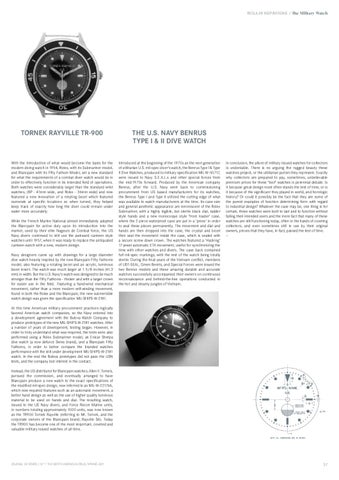Regular inspirations / The Military Watch
Tornek Rayville TR-900
The U.S. Navy Benrus Type I & II Dive Watch
With the introduction of what would become the basis for the modern diving watch in 1954, Rolex, with its Submariner model, and Blancpain with its Fifty Fathom Model, set a new standard for what the requirements of a combat diver watch would be in order to effectively function in its intended field of operations. Both watches were considerably larger than the standard wrist watches, (BP - 41mm wide, and Rolex - 36mm wide) and now featured a new innovation of a rotating bezel which featured numerals at specific locations so when turned, they helped keep track of exactly how long the diver could remain under water more accurately.
Introduced at the beginning of the 1970s as the next generation of utilitarian U.S. mil-spec diver's watch, the Benrus Type I & Type II Dive Watches, produced to military specification MIL-W-50717, were issued to Navy S.E.A.L.s and other special forces from the mid-1970s forward. Produced by the American company Benrus, after the U.S. Navy went back to commissioning procurement from US based manufacturers for its watches, the Benrus Type I and Type II utilized the cutting edge of what was available to watch manufacturers at the time. Its case size and general aesthetic appearance are reminiscent of the Rolex Submariner, with a highly legible, but sterile black dial, ladder style hands and a new monocoque style 'front loader' case, where the 2 piece waterproof case are put in a 'press' in order to seal these pieces permanently. The movement and dial and hands are then dropped into the case, the crystal and bezel then seal the movement inside the case, which is sealed with a secure screw down crown. The watches featured a 'Hacking' 17 jewel automatic ETA movement, useful for synchronizing the time with other watches and divers. The case back contained full mil-spec markings, with the rest of the watch being totally sterile. During the final years of the Vietnam conflict, members of UDT-SEAL, Green Berets, and Special Forces were issued the two Benrus models and these amazing durable and accurate watches successfully accompanied their owners on continuous reconnaissance and behind-the-line operations conducted in the hot and steamy jungles of Vietnam.
While the French Marine National almost immediately adopted the Blancpain for active duty upon its introduction into the market, used by their elite Nageurs de Combat force, the US Navy divers continued to still use the awkward canteen style watches until 1957, when it was ready to replace the antiquated canteen watch with a new, modern design. Navy designers came up with drawings for a large diameter dive watch heavily inspired by the new Blancpain Fifty Fathoms model, also featuring a rotating bezel and an acrylic, luminous bezel insert. The watch was much larger at 1 5/8 inches (41.3 mm) in width. But the U.S. Navy's watch was designed to be much stronger than the Fifty Fathoms - thicker and with a larger crown for easier use in the field. Featuring a hand-wind mechanical movement, rather than a more modern self-winding movement, found in both the Rolex and the Blancpain, the new submersible watch design was given the specification MIL-SHIPS-W-2181.
In conclusion, the allure of military issued watches for collectors is undeniable. There is no arguing the rugged beauty these watches project, or the utilitarian purism they represent. Exactly why collectors are prepared to pay, sometimes, unbelievable premium prices for these "tool" watches is perennial debate. Is it because great design most often stands the test of time, or is it because of the significant they played in world, and horologic history? Or could it possibly be the fact that they are some of the purest examples of function determining form with regard to industrial design? Whatever the case may be, one thing is for certain, these watches were built to last and to function without failing their intended users and the mere fact that many of these watches are still functioning today, often in the hands of coveting collectors, and even sometimes still in use by their original owners, proves that they have, in fact, passed the test of time. —
At this time American military procurement practices logically favored American watch companies, so the Navy entered into a development agreement with the Bulova Watch Company to produce prototypes of the new MIL-SHIPS-W-2181 watches. After a number of years of development, testing began. However, in order to truly understand what was required, the tests were also performed using a Rolex Submariner model, an Enicar Sherpa dive watch (a now defunct Swiss brand), and a Blancpain Fifty Fathoms, in order to better compare the branded watches performance with the still under development MIL-SHIPS-W-2181 watch. In the end the Bulova prototypes did not pass the USN tests, and the company lost interest in the contact. Instead, the US distributor for Blancpain watches, Allen V. Tornek, pursued the commission, and eventually arranged to have Blancpain produce a new watch to the exact specifications of the modified mil-spec design, now referred to as MIL-W-22176A, which now required features such as an automatic movement, a better hand design as well as the use of higher quality luminous material to be used on hands and dial. The resulting watch, issued to the US Navy divers, and Force Recon Marine units, in numbers totaling approximately 1000 units, was now known as the TR900 Tornek Rayville (referring to Mr. Tornek, and the corporate owners of the Blancpain brand, Rayville SA). Today the TR900 has become one of the most important, coveted and valuable military issued watches of all time.
JOURNAL DE NĂŽmes / NÂş 7 the north american issue, spring 2011
37
